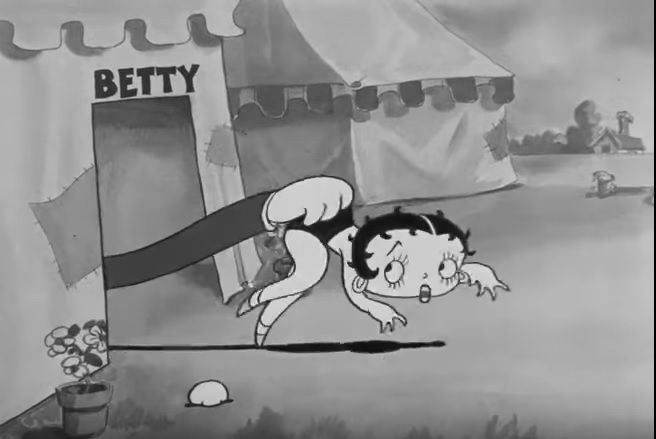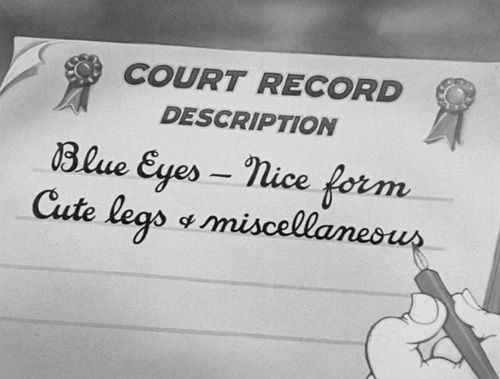
A ringmaster threatens Betty Boop’s job if she doesn’t reciprocate his advances.
In the wake of the allegations of abuse against Harvey Weinstein and many other powerful Hollywood men, the “film colony”—as Hollywood was originally known—is under public scrutiny, yet again, for its dark abuses of power. 2017’s outcry recalls Hollywood’s younger days in the 1920s, when American newspapers were also condemning Hollywood after startling revelations of violence and harassment behind the cameras and glamorous makeup. But the flood of allegations of abuse also reminds me of the products Hollywood put out for all to see: its early cartoons, which often casually depicted a wide, sometimes startling range of abuse against women, with some even seemingly condemning harassment (even, of course, as women were being harassed off-screen).
The best cartoons hold a mirror to our world.
Nowadays, Walt Disney’s best-known animated features often serve as stereotypical icons of “family-friendly” entertainment, but some of Disney’s older projects depart from that image. In Mickey Mouse’s first cartoon, “Plane Crazy” (previewed in 1928, the same year as “Steamboat Willie,” the more successful cartoon that cemented the mouse’s popularity), Disney’s anthropomorphic icon acts quite differently from how he does today: while taking Minnie on a ride in a makeshift airplane, Mickey gestures to Minnie to kiss him multiple times, and, after she rebuffs him, he simply grabs her and forces her into a kiss, a common trope of harassment in cartoons. She slaps him and leaves the plane. The cartoon depicts its womanizer as a buffoon who, after Minnie’s rejection, comically crashes his eponymous plane, yet the casualness with which Mickey decides to force romance upon a female character is disconcerting. In such small ways, Hollywood’s earliest cartoons reflected the commonplace nature of the harassment that would soon come to define the industry.

Mickey forces Minnie to kiss him—a common trope of animated sexual harassment in early Hollywood cartoons.
Six years before Mickey’s debut on the screen, Disney was producing a series of grainily animated retellings of classic folktales with Laugh-o-Gram Films between 1922 and 1923, some of which featured more pronounced harassment. Disney’s Little Red-Riding Hood, for instance, transformed the fairy tale into an analogue of sexual predation. In it, Red Riding Hood travels to deliver sweets to her grandmother; along the way, she meets a grinning man in a fancy automobile, who then speeds ahead, lecherous smile unswerving from his face, to her destination. Once there, he hides inside and waits. Moments after Red Riding Hood enters the house, she screams. Perhaps more disturbingly, what the man attempts to do to her is never revealed, and she is only saved by chance, when another man, alerted by Red Riding’s Hood agitated dog, hurries to the grandmother’s house to rescue her. The Big Bad Wolf, stripped of layers of symbolism, has slipped from carnivorous to carnal predator: he is now, merely and more disquietingly, a man preying on girls, a threat to be found far beyond the forest the folktale’s original wolf hunts in, a threat many women in the industry—and outside it—would have recognized well.
The most overt depiction of sexual harassment in early Hollywood cartoons arguably appeared in Max Fleischer’s Betty Boop, which frequently featured men attempting to coerce its iconic protagonist into sexual acts. In many shorts, Betty Boop’s confident, unabashed sexuality was on full display, and, along with it, a seemingly endless display of animated risque behavor, in which nearly every male character—even animated objects—becomes a lothario, crassly lusting after her. Her abusers, however, were often punished on screen, sometimes by Betty Boop herself, lending a didactic element to her show.
In Fleischer’s most disconcerting cartoons, men try to rape Betty Boop on-screen, like “Boop-Oop-a-Doop” (1932), in which a gargantuan ringmaster she works for fondles her leg and tells her that unless she sleeps with him, she will lose her job, dragging her back into her tent when she shrieks and attempts to flee. “Don’t take my boop-oop-a-doop away,” she sings, implying that her boss wishes to forcibly take her virginity. (Betty’s companions, Koko and Bimbo, save her.)

The ringmaster drags Betty back into her tent after threatening her job if she doesn’t sleep with him.
In others, she successfully, if with the ease afforded by being in a cartoon’s pliable landscape, fights back. “Red Hot Mamma” (1934) finds Betty Boop traveling to hell in a dream on a chilly winter night; hell, unlike her cottage, is fiery-hot, and, as the temperature rises, so do the libidos of the lecherous male demons who stalk and eventually surround her, grinning and salacously licking their lips. Betty, however, is having none of it, and literally freezes hell over with icy stares at her chthonic harassers, allowing her to escape.
The 1934 “Betty Boop’s Trial” even touched on sexualized police harassment. A male officer ogles Betty as she drives by and, after wolf-whistling and declaring, “boy, did you see that,” follows her, demanding that she stop so, presumably, he could flirt—or more—with her. When she refuses, he chases her in indignation until her car crashes, arrests her for “resisting an officer,” and brings her to court, wherein a lewd judge, instead of writing down her testimony, records her “nice form” and “cute legs” on his legal pad.

The judge, following the trope of the perverted old man, describes Betty Boop’s body more than her testimony.
Another 1934 short, “Betty Boop’s Big Boss,” explored workplace sexual harassment. When a company erects a sign calling for a female secretary, women flood into the corporate building—designed with vaguely phallic architecture—to apply, heading to its top floor. The enormous, grotesque boss selects Betty based on her looks; when he asks what she can do, however, she seems to reciprocate his lust with flirty suggestions. The boss hires her and stares greedily at Betty as she types. Soon, he asks her for a kiss. When she rebuffs him, he begins to chase her, even as she repeatedly says no. His building, suddenly alive, seems to channel his desires and, chillingly, the doors lock, trapping Betty in with her aggressor. She calls the police. The officers shoot at the boss, and Betty fires pencil stubs at him from a sharpener. Eventually, the officers shoot the building’s base, making it shrink floor by floor, until they find Betty and the boss kissing, seemingly consensually, on the now-bottom level; the tower, a sexual symbol, has been brought down to size, reducing the boss’ violent libido along with it.
This cartoon is more morally ambivalent, even contradictory, about harassment than Fleischer’s others, but the boss is still clearly an abusive aggressor, refusing to take no for an answer and even locking doors to prevent his target’s escape, the latter recalling allegations that Weinstein predatorily locked a woman in a hotel room.
These cartoons began to appear in the same decade as Hollywood’s first major scandals, which quickly came to dominate the American media’s view of that mysterious, near-mythic, world. In 1920, the silent film actress Olive Thomas made international headlines for two weeks when she was discovered dead from poisoning, sparking off what was, arguably, the first truly notorious scandal for Hollywood.
The most transformative of these early scandals, however, was the infamous Arbuckle-Rappe affair in 1921, which I wrote about: Hollywood’s first publicly dissected sex scandal, wherein an American actress, Virginia Rappe, was allegedly fatally assaulted by Roscoe “Fatty” Arbuckle—then one of America’s most famous actors, second in recognition only to Charlie Chaplin—at a wild party; Arbuckle was arrested, indicted, and ultimately (if with questions left unanswered) acquitted in a lurid trial that dominated headlines. Hollywood itself, suddenly, was on trial. It didn’t help that the following year, while Arbuckle was in court, the respected actor and director William Desmond Taylor was murdered under enigmatic circumstances in his home, prompting a new wave of media sensationalism and moral outrage towards Hollywood—and, because Taylor was posthumously outed as queer, his death prompted fury towards actors suspected of being queer, as well.
The veil had been lifted, at least for those who initially imagined the world of filmmaking carefree but innocent: Hollywood was a sybaritic shadow-world of drugs, promiscuity, murder. Tinseltown—Hollywood’s later pejorative sobriquet, suggesting a land of false glitter—suddenly seemed less pretty and promising than predatory and pugnacious.
These cartoons evoke a now-all-too-familiar image of Hollywood rife with sexual predation, both on and off the screen. Harassment was braided to the industry from its beginnings; there were many Weinsteins before Weinstein. On the one hand, these cartoons reflected the crude machismo of an era; on the other, it’s salient how little the fabric of things has changed. They show, in their way, what we have too frequently come to expect as women. When not explicit, it’s often the language of little things: the locked doors, the assumptions these men, animated or actual, make about what we want or will assent to.
That some of these animated features also implicitly condemned harassment is all the more ironic, given that the Betty Boops who existed off-screen didn’t always have friends to save them from those terrifying bosses, who, then as now, threatened their jobs if they didn’t reciprocrate their sexual advances, and who represented why so many women learn to fear men: not because all men are predators, but because we learn the sad, terrifying fact that we can never know which ones are not.
